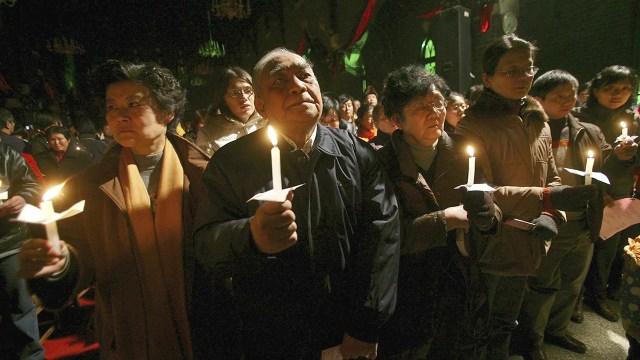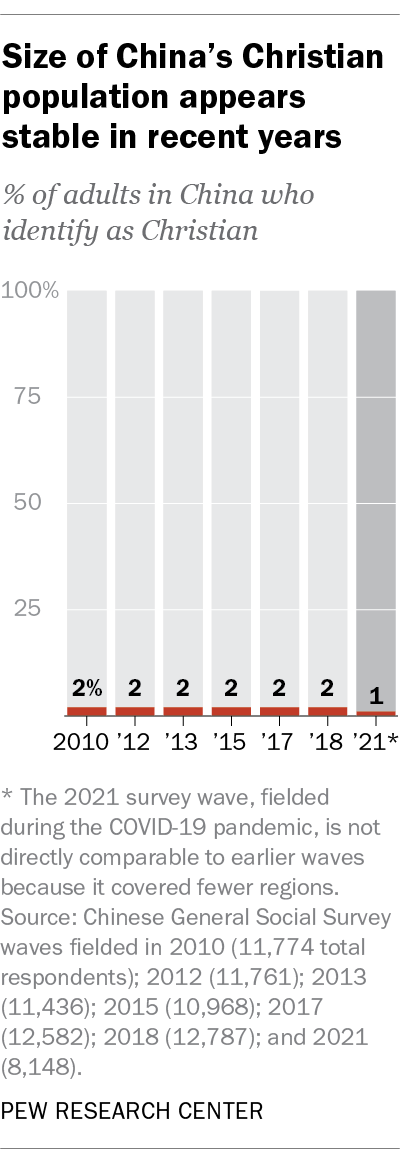
The Chinese government banned religion during the Cultural Revolution of the 1960s and ’70s. And although Christianity and other religions bounced back in the 1980s and ’90s as restrictions were lifted, the size of China’s Christian population now appears to have leveled off, according to a Pew Research Center analysis of the latest available survey data collected by academic organizations in China.
This analysis of China’s Christian population is based on Pew Research Center’s August 2023 report Measuring Religion in China. Since the Center, like other non-Chinese organizations, is not allowed to conduct surveys in China, this post draws on data collected between 2010 and 2021 in the Chinese General Social Survey (CGSS), a nationally representative survey conducted by the National Survey Research Center at Renmin University of China. Most CGSS waves include about 12,000 respondents. Other surveys by academic organizations in China find similar results about the size of China’s Christian population. The report chapter on Christianity has more detail.
This post also discusses Chinese government data on religion, which is primarily released by China’s State Council and the National Religious Affairs Administration – formerly known as the State Administration for Religious Affairs – and data from state-run religious associations, such as the China Christian Council and the Three-Self Patriotic Movement (CCC and TSPM).
This research is part of the Pew-Templeton Global Religious Futures project, which analyzes religious change and its impact on societies around the world.
No survey assessed the Chinese religious landscape in the years immediately following the Cultural Revolution, but government figures suggest that the number of Christians worshipping in registered churches in China more than doubled, from 6 million in 1982 to 14 million in 1997. By comparison, the country’s overall population increased by a more modest 22% during that period.
There was also reported growth in the number of Christians worshipping in “underground” or “house” churches, which are not registered with the state-sanctioned Catholic and Protestant associations (the Catholic Patriotic Association and the Three-Self Patriotic Movement).
Some journalists, scholars and Christian advocacy groups have suggested that Christianity in China continues to grow rapidly in the 21st century and that Christians are on track to make up a majority of the population there by 2050.

But survey data from the Chinese General Social Survey (CGSS) does not show ongoing growth. Between 2010 and 2018, the share of Chinese adults who formally identify with Christianity remained stable at about 2%, according to the CGSS. Roughly nine-in-ten Christians in China are Protestant.
Some scholars have suggested that the coronavirus pandemic prompted increased religiosity in China. But the most recent wave of the CGSS – conducted in 2021, during the pandemic – provides no hint of a revival of Christian identity. Only 1% of respondents formally identified with Christianity that year.
It’s important to note that the 2021 survey data is not directly comparable to earlier waves because COVID-19 outbreaks in some regions of China made it impossible to achieve the same coverage as in pre-pandemic waves.
Survey-based estimates of China’s Christian population may be conservative
In China, religious identity can be measured through data points from many surveys. But religious identity alone may be a conservative measure of religion’s influence in China.
More Chinese adults share some Christian beliefs than identify with the faith in surveys. In the 2018 China Family Panel Studies survey, for instance, 3% of respondents reported exclusively believing in the Christian God (the survey measured belief in Jesus Christ and in Tianzhu, the Chinese word for God used by Catholics). An additional 4% said they believe in the Christian God and at least one other non-Christian deity.
More broadly, all survey-based estimates of China’s Christian population could be conservative. Some people may choose not to reveal Christian identity because they fear negative social or financial consequences should their identity become known, especially if they belong to an unregistered church.
Christianity in China has faced increased restrictions since Xi Jinping became president in 2013. We cannot be certain how survey patterns are affected by political circumstances. Hypothetically, there could be a real increase in the share of Chinese adults who identify with Christianity that is hidden from survey measurement. This could be the case if respondents are increasingly reluctant to reveal their Christian identity due to the government’s intensifying scrutiny of religious activity.
Why China’s Christian population may be leveling off
Although we can’t be certain how precisely surveys capture the reality of China’s religious landscape, there are several reasons why it’s plausible that the country’s Christian population is plateauing.
Government policies that monitor and discourage religious activity may have prevented some Chinese people from becoming or remaining Christian. An official ban on religious education and activity for children, for example, may be inhibiting the transmission of Christian identity to the next generation. Demographics also pose obstacles to Christian growth in China. The CGSS indicates that Christians are concentrated among older adults and relatively scarce among younger Chinese.
Among remaining Christians, the government’s recent program of absorbing previously unregistered churches into the official system may have removed one reason for people to conceal their Christian identity.
Other estimates of the Christian count in China vary widely
The Chinese government has occasionally published statistics estimating how many people associate with Christianity and other religions. However, it’s often unclear how these estimates were derived and whether they are comparable to earlier government figures. Government statistics also vary in the extent to which they include members of unregistered churches, and it is often unclear whether they include children or not.
In 2010, the Chinese Academy of Social Sciences (CASS) Blue Book on Religion estimated there were 23 million Protestants in China. This government estimate, based for the first time on a nationally representative household survey, included members of the official state-sanctioned Three-Self Patriotic Movement, as well as house church members.
When this estimate was challenged by Christian leaders, CASS fellows Duan Qi and Huang Haibo responded that the survey showed the number of Protestants was at least 23 million, but that because of possible underreporting, the total count could be up to 40 million. The next year’s edition of the Blue Book, in 2011, said the Protestant population was in the 23 million to 40 million range (2% to 3% of Chinese people of all ages).
In 2018, the State Council of the People’s Republic of China White Paper on Religious Freedom reported there were 38 million Protestants, but the paper did not detail how this estimate was made. Around this time, a Peking University study estimated that the total number of adults who either formally identify as Christian, profess Christian beliefs or regularly attend Christian worship services, including Protestants and Catholics, was about 40 million, based on analysis of measures from China Family Panel Studies surveys.
Several Christian organizations claim that the count of Christians in China has continued to grow steadily and that it is much higher than survey data or government statistics indicate. For example, the Center for the Study of Global Christianity estimates that the Christian share of China’s population of adults and children increased from 6% in 2000 to 7% in 2020. And Asia Harvest, a Christian ministry that works to expand the number of churches in Asia, estimates that Christians grew from 8% of the country’s total population in 2010 to 9% in 2020.
Related: 8 key findings about Christians in India and How many Christians are there in Egypt?
